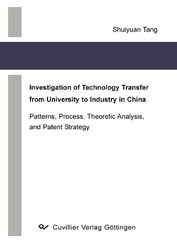| Departments | |
|---|---|
| Book Series (96) |
1378
|
| Nachhaltigkeit |
3
|
| Gesundheitswesen |
1
|
| Humanities |
2365
|
| Medienwissenschaften | 16 |
| Theology | 57 |
| Philosophy | 102 |
| Law | 422 |
| Economics | 850 |
| Social sciences | 416 |
| Sports science | 48 |
| Psychology | 233 |
| Educational science | 190 |
| History | 182 |
| Art | 111 |
| Cultural studies | 166 |
| Literary studies | 117 |
| Linguistics | 88 |
| Natural Sciences |
5406
|
| Engineering |
1793
|
| Common |
98
|
|
Leitlinien Unfallchirurgie
5. Auflage bestellen |
|
Advanced Search
Investigation of Technology Transfer from University to Industry in China (English shop)
Patterns, Process, Theoretic Analysis, and Patent Strategy
Shuiyuan Tang (Author)Preview
Table of Contents, Datei (34 KB)
Extract, Datei (62 KB)
Science and technology became a major driving force of economic growth in the early 20th century. It contributed 60-80% to economic growth in developed countries and 30.1% in China at the end of the 20th century by means of talent training, research and development (R&D;) and technology transfer.
University technology transfer in China became well accepted by both industry and university in 1990s. At the beginning of the 1990s, the commercialization of Chinese university’s R&D; achievements became well recognized and popular. Technology transfer from university to industry in China was then regarded as one of the major driving forces in revitalizing science, technology and the economy. It was therefore adopted as the third basic function of the universities, sharing equal importance with teaching and R&D.; Consequently, the study of technology transfer from university to industry in China is necessary and significant, because it offers an approach to understand why China could maintain long-term high-speed economic growth and stable development in science and technology. This study outlines a comprehensive perspective of technology transfer from university to industry in China, including Chinese university’s R&D; system which determines the basis of university technology transfer, the basic patterns of technology transfer, theoretical model outlining the inner structure and process of technology movement from university to industry, and the patent system in China’s universities and technology transfer related IPRs protection. Last but not least, we make a comparative study on university technology transfer in Germany and China.
The monograph is divided into 7 chapters.
Chapter one presents the necessity and objectives, research methods and dissertation structure of the study, basing on review of literature review and analysis of technology transfer activities in China’s universities. It concludes that technology transfer from university to industry in China is a necessary choice for universities to realize self-development and actualization of the three missions established by the government, and that it contributes greatly to the enhancement of Chinese enterprises’ technological innovation capacity.
Chapter two gives a historical overview of China’s university R&D; and its role in a national innovation system. It outlines the developmental history of China’s universities and the formation of the university’s R&D; mechanism. The chapter emphasizes on the substantial contribution of China’s universities to national innovation systems. It analyzes in detail the main structure of the university R&D; system and activities, which are the base of university technology transfer. It is obvious that applied research and experimental development dominate the university’s R&D; activities, which make university technology transfer possible.
Chapter three focuses on three basic patterns of technology transfer from university to industry in China. These are collaborative research, technology assignment, and university-owned scientific & technological enterprises (which is the Chinese-featured university spin-off). Each pattern is analyzed with a detailed description of data, the process of technology movement, and a case study.
Chapter four introduces technology-drive and market-demand (TD-MD) model to explain theoretically the inner structure and process of technology movement from university to industry in university technology transfer.
Chapter five discusses the Chinese university patent system and technology transfer related IPRs protection. It shows that patent plays an important role in Chinese university technology transfer. Among the principal patterns of technology transfer from university to industry in China, patent license is increasing gradually and will become the primary pattern of university technology transfer in the near future in China. A small-sized enterprise (SME) orientated IPRs strategy in university is initiated.
Chapter 6 contrasts university technology transfer in Germany and China from 5 aspects: (1) different tertiary education systems in which university technology transfer occurs, (2) different innovation and R&D; systems on which university technology transfer depends, (3) different resource of university R&D; funds which define the basis of university technology transfer, (4) different management structures and policies of university technology transfer, and (5) different channels and patterns of university technology transfer in the two nations.
Chapter seven concludes the study and offers recommendations for future development of technology transfer in China’s universities.
| ISBN-13 (Printausgabe) | 3867277192 |
| ISBN-13 (Hard Copy) | 9783867277198 |
| ISBN-13 (eBook) | 9783736927193 |
| Language | English |
| Page Number | 284 |
| Edition | 1 Aufl. |
| Volume | 0 |
| Publication Place | Göttingen |
| Place of Dissertation | TU Cottbus |
| Publication Date | 2008-08-27 |
| General Categorization | Dissertation |
| Departments |
Law
Economics |
| Keywords | University technology transfer, technology management, comparative study, innovation system, collaborative research, technology assignment, universi-ty-owned scientific & technological enterprises, R&D;, TD-MD model, IPRs protection, China, Germany. |








